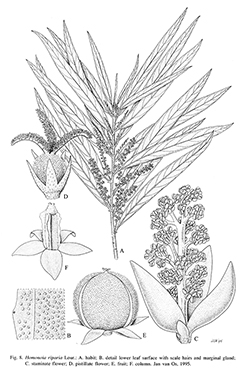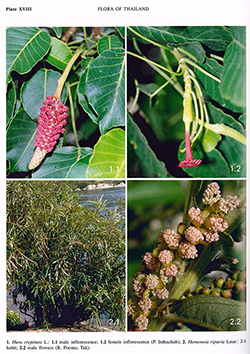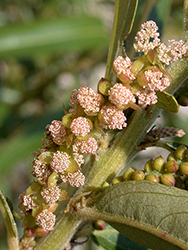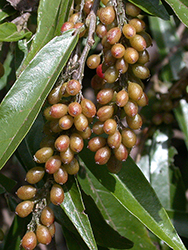e-Flora of Thailand
Volume 8 > Part 2 > Year 2007 > Page 336 > Euphorbiaceae > Homonoia
Homonoia riparia Lour.wfo-0000214976
Fl. Cochinch.: 637. 1790; Müll.Arg. in DC., Prodr. 15, 2: 1023. 1866; Pax & K.Hoffm. in Engl., Pflanzenr. IV. 147. xi: 114, fig. 27a-e. 1919; Gagnep. in Lecomte, Fl. Indo-Chine 5: 330, fig. 38: 5–8. 1925; Airy Shaw, Kew Bull. 26: 282. 1971; Whitmore, Tree Fl. Malaya 2: 103. 1973; Steenis, Rheoph. World: 241. 1981; Welzen, Blumea 43: 138, fig. 2, map 1. 1998. Fig. 8; Plate XVIII: 2.
Accepted Name : This is currently accepted.
Description : Shrub (to small tree), up to 2(–7) m high. Stipules 4.8–6.5 by 0.5–1.2 mm. Leaves: petiole 4–13 mm long; blade narrowly elliptic (to obovate), 3.5–21 by 0.5–2.5 cm, length/width ratio 5–14, above dark green, below silvery to whitish to glaucous, venation raised on both sides, nerves 13–16 per side. Inflorescences up to 7(–10) cm long, dirty greenish-yellow with a reddish tinge. Staminate flowers 4.5–5 mm in diam.; sepals ovate to elliptic, 2.8–4.3 by 0.8–3.3 mm, outside dark red, inside very pale reddish-pink; androphore 3–5.8 mm high, white, connective dark red; anthers ca 0.4 by 0.2 mm, white to yellow. Pistillate flowers ca 2 mm in diam.; sepals ovate, 1.1–2.3 by 0.4–1.1 mm, dull green tinged reddish; ovary globose, 0.8–2 by 0.7–2 mm, style 0(–0.3 mm long, cream); stigmas 1.4–4 mm long, reddish-brown. Fruits 3.2–4.5 by 2.7–4 mm, (yellowish-red to) brown (to blackish); wall thin, less than 1 mm thick. Seeds 1.3–1.8 by 1.8–2.2 by 1–1.5 mm.
Thailand : NORTHERN: Mae Hong Son, Chiang Mai, Chiang Rai, Nan, Lampang, Phrae, Tak, Sukhothai, Phitsanulok; NORTH-EASTERN: Phetchabun, Loei, Khon Kaen; EASTERN: Nakhon Ratchasima; SOUTH-WESTERN: Uthai Thani, Kanchanaburi, Ratchaburi; CENTRAL: Nakhon Nayok; SOUTH-EASTERN: Prachin Buri, Chanthaburi, Trat; PENINSULAR: Chumphon, Surat Thani, Trang, Yala, Narathiwat.
Distribution : Bhutan, India, Sri Lanka, Burma, China, Taiwan, Laos, Cambodia, Vietnam (type), and throughout Malesia (on Borneo Sabah only), but rare towards the east (Maluku, New Guinea).
Ecology : Rheophyte, usually in groups on river banks, in rocky (fast running) stream beds, and along the coast; soil usually (temporarily) inundated, in some areas for months; soil: limestone, rocks (gravel), sand. Anchorage of the plants superb (Steenis, 1981). Flowers are presumably wind pollinated. The seeds are very hard and durable; they sink in water and may be transported by the river into even the sea, where they can still germinate in salt water along the coast, 0–700 m alt.
Vernacular : Khrai (ไคร้), khrai nam (ไคร้น้ำ)(Northern); hia-thi (เหี่ยที้), si-thi-kho (สี่ที่โค่)(Karen-Mae Hong Son); khrai hin (ไคร้หิน), rae (แร่)(Chumphon); ka-lae-rae (กะแลแร)(Malay-Yala); klae-rae (แกลแร)(Malay-Narathiwat).
Uses: The plant is used as medicine against different diseases. Laos: decoction of leaves to be used against itch. Cambodia: stem and leaves are used as a medicine to clear the skin of diseases, young leaves and shoots produce hair oil, and wood is used in an infusion against malaria. Thailand: mashed and powdered leaves are a treatment against skin eruption. Malaysia (N. Perak): pounded leaves and fruits are used against skin diseases too, either in a poultice and/or as a decoction to be drunk. Java: used to fasten loose teeth, S. Philippines: the plant may be a stimulant against certain venereal diseases; a root decoction acts as an emetic, while water running at the foot of the shrubs may have depurative properties. Due to the elaborate and large root system the plant is used in N. Sumatra and Java to protect river banks or is planted to prevent erosion. The saps of the plant may dye teeth black (Java). In South China the bark is used as rope. The leaves are used for forage in Vietnam. The root is used to make bolo handles (Sabah, N. Borneo).






